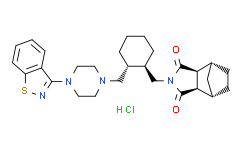| Cas No.: | 367514-88-3 |
| Chemical Name: | Lurasidonhydrochloride |
| Synonyms: | Lurasidonhydrochloride;Lurasidone HCl;Lurasidone Hydrochlo;Lurasidone Hydrochlorid;Lurasidone hydrochloride;Lurasidone hydrochloride solution;SM-13496;Latuda;Lurasidone (Hydrochloride);SM 13496;Lurasidone impurity 4;((3aR,4S,7R,7aS)-2-{(1R,2R)-2-[4-(1,2-benzisothiazol-3-yl)piperazin-1-ylmethyl]cyclohexylmethyl}hexahydro-4,7-methano-2H-isoindole-1,3-dione hydrochloride;N-(2-(4-(1,2-benzisothiazol-3-yl)-1-piperazinylmethyl)-1-cyclohexylmethyl)-2,3-bicyclo(2.2.1)heptanedicarboximide hydrochloride;(3aR,4S,7R,7aS)-2-[[(1R,2R)-2-[[4-(1,2-Benzisothiazol-3-yl)-1-piperazinyl]methyl]cyclohexyl]methyl]hexahydro-4,7-methano-1H-isoindole-1,3(2H)-dione hydrochloride |
| SMILES: | O=C([C@H]([C@H]1CC[C@@H]2C1)[C@H]2C3=O)N3C[C@@H]4CCCC[C@H]4CN(CC5)CCN5C6=NSC7=CC=CC=C76.Cl |
| Formula: | C28H37ClN4O2S |
| M.Wt: | 529.137 |
| Purity: | >98% |
| Sotrage: | 2 years -20°C Powder, 2 weeks 4°C in DMSO, 6 months -80°C in DMSO |
| Description: | Lurasidone is an antagonist of both dopamine D2 and 5-HT7 with IC50s of 1.68 and 0.495 nM, respectively. Lurasidone is also a partial agonist of 5-HT1A receptor with an IC50 of 6.75 nM. |
| In Vivo: | Lurasidone dose-dependently increases the ratio of DOPAC/dopamine in both regions, but it shows a preferential effect on the frontal cortex compare with the striatum, especially at higher doses. Lurasidone (ED50 values 2.3 to 5.0 mg/kg) shows a comparable potency with olanzapine (ED50 values 1.1 to 5.1 mg/kg), higher potency than clozapine (ED50 9.5 to 290 mg/kg), and slightly lower potency than haloperidol (ED50 values 0.44 to 1.7 mg/kg). Lurasidone (1 to 10 mg/kg) dose-dependently inhibits conditioned avoidance response (CAR) in rats, and the ED50 values are 6.3 mg/kg. Lurasidone dose-dependently inhibits TRY-induced forepaw clonic seizure and p-CAMP-induced hyperthermia with ED50 values of 5.6 and 3.0 mg/kg, respectively. Lurasidone (0.3 to 30 mg/kg) dose-dependently and significantly increases the number of shocks received by rats in the conflict test with MED of 10 mg/kg (p<0.01)[1]. |
| In Vitro: | Lurasidone is an antagonist of dopamine D2 and 5-HT7 with IC50s of 1.68±0.09 and 0.495±0.090 nM, respectively. Lurasidone is also a partial agonist of 5-HT1A receptor with an IC50 of 6.75±0.97 nM. In vitro receptor binding experiments reveal that Lurasidone demonstrates affinity for dopamine D2 and 5-HT2A receptors higher than other tested antipsychotics. Lurasidone does not increase [35S]GTPγS binding to the membrane preparations for dopamine D2 receptors by itself, but it antagonizes dopamine-stimulated [35S]GTPγS binding in a concentration-dependent manner with a KB value of 2.8±1.1 nM[1]. |
| Kinase Assay: | [35S]GTPγS binding experiments for the human dopamine D2L or 5-HT1A receptors stably expressed in the membranes of recombinant Chinese hamster ovary (CHO) cells are performed. Shortly after dopamine (or serotonin) and/or Lurasidone are incubated for 20 min at room temperature with the cell membrane preparation containing [35S]GTPγS (0.05 nM for D2L or 0.2 nM for 5-HT1A), the membranes are filtered through glass filters and the radioactivity bound to each filter is measured with a liquid scintillation counter[1]. |
| Animal Administration: | SD rats are individually isolated in clear plastic cages and injected with methamphetamine (MAP) (1 mg/kg i.p.) 1 h after the administration of drugs or vehicle. In the test of persistence of the effect, Lurasidone is administered 1, 2, 4, and 8 h before the MAP injection. Locomotor activity is measured for 80 min from 10 min after MAP injection. Four or five groups of 6 to 13 rats are used to calculate the ED50 value that inhibits MAP-induced hyperactivity by 50% of the animals tested[1]. |
| References: | [1]. Ishibashi T, et al. Pharmacological profile of lurasidone, a novel antipsychotic agent with potent 5-hydroxytryptamine 7 (5-HT7) and 5-HT1A receptor activity. J Pharmacol Exp Ther. 2010 Jul;334(1):171-81. [2]. Sakine Atila Karaca, et al. Development of a validated high-performance liquid chromatographic method for the determination of Lurasidone in pharmaceuticals. Marmara Pharm J. 2017;21 (4): 931-937. |






















